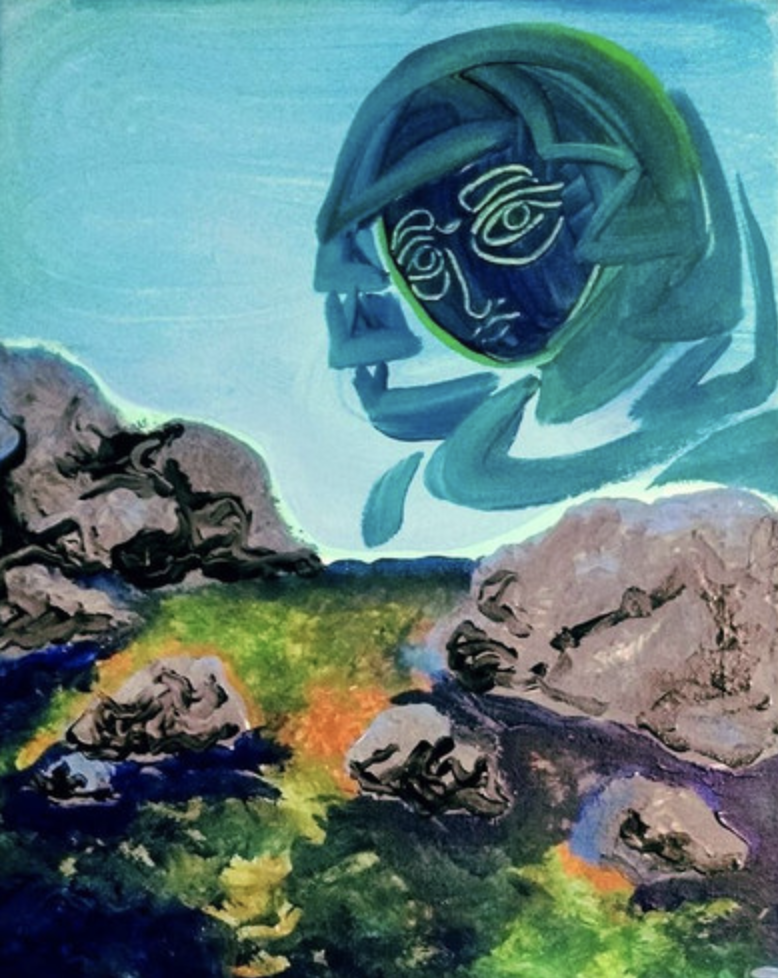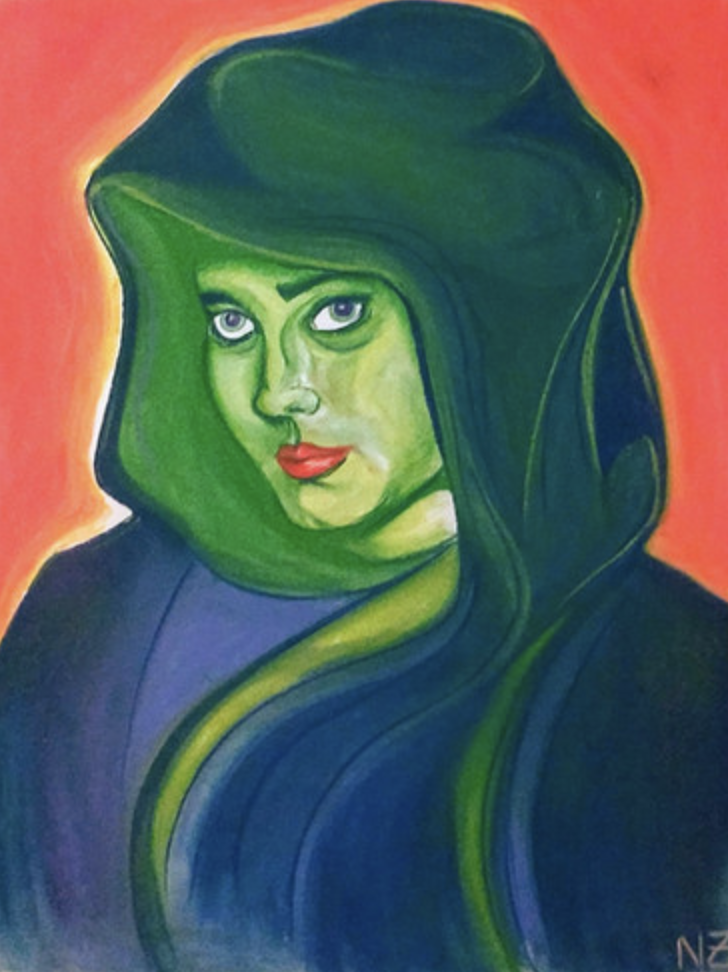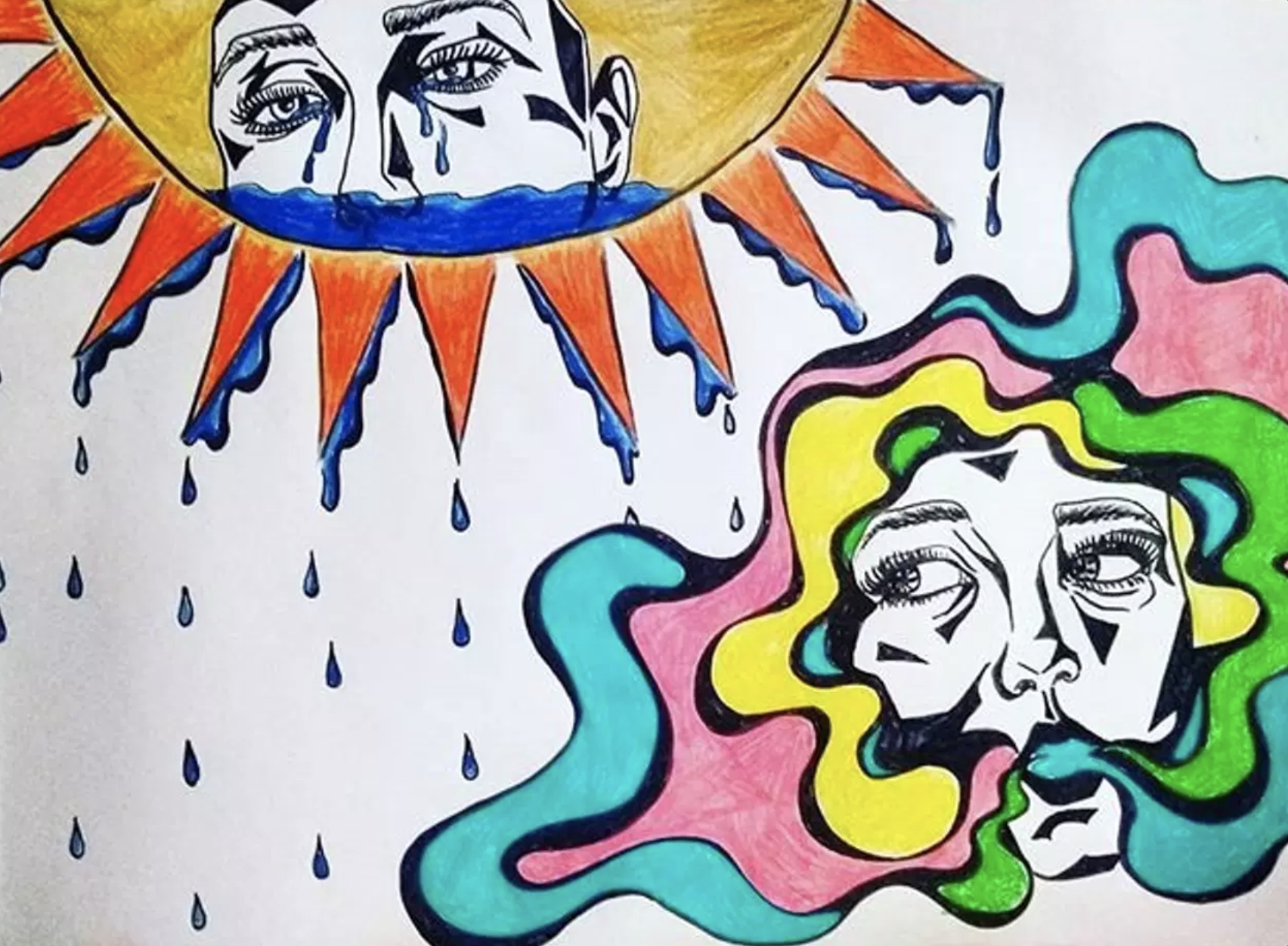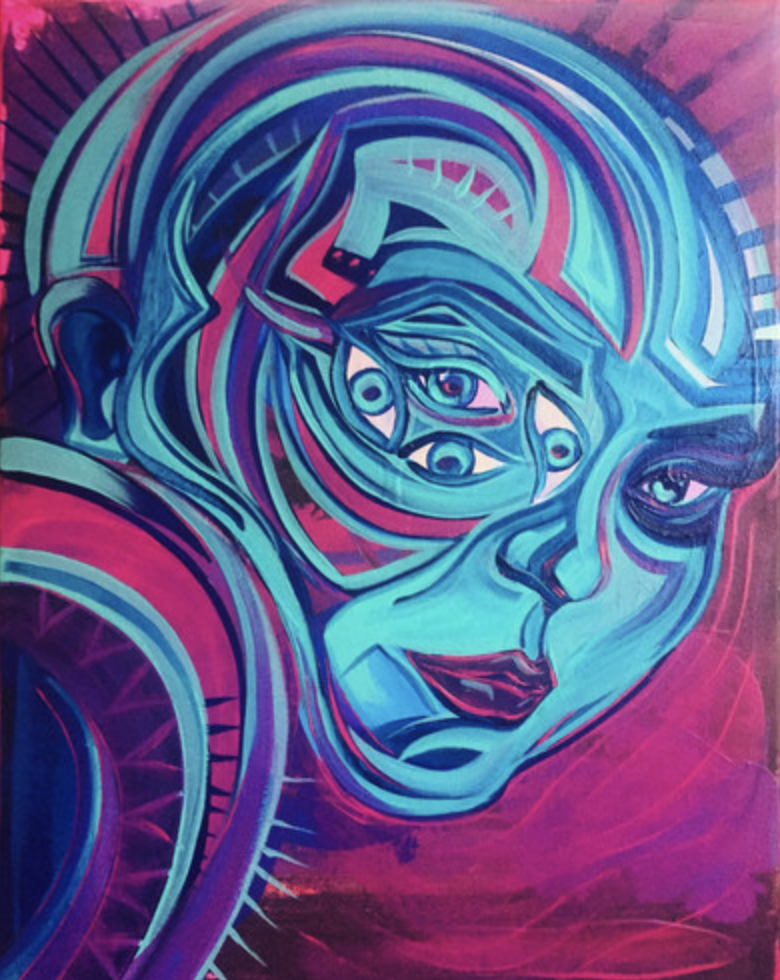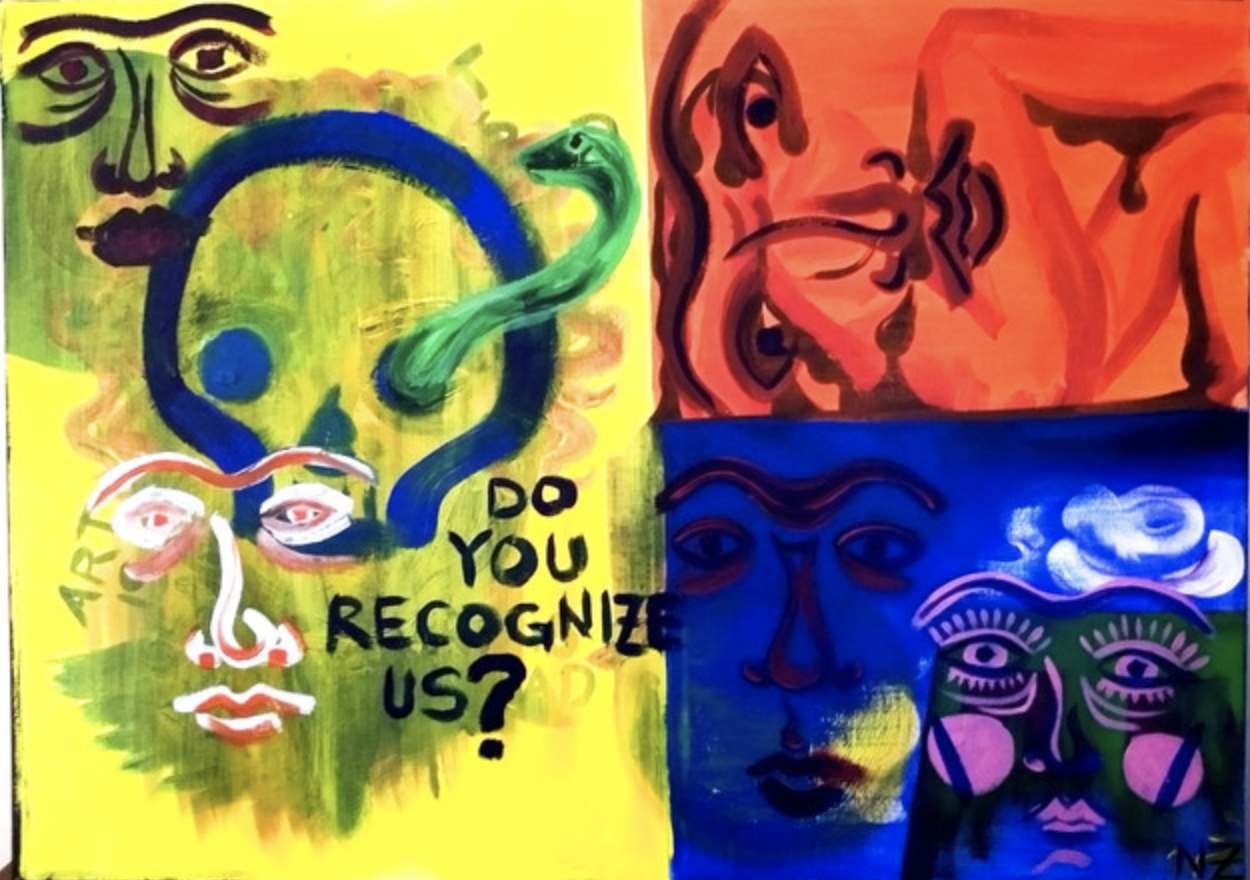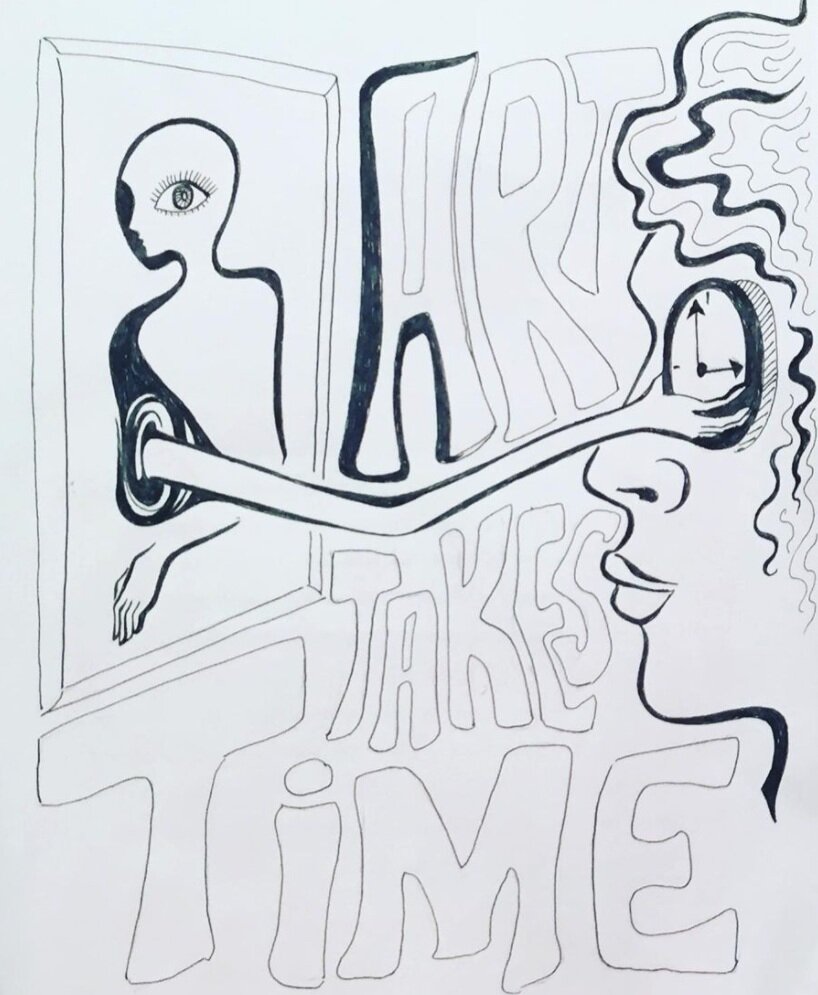New Art Grows from Something Decadent: an Interview with Natasha Zinos ‘21
by Eleni Krupinski ‘21
Natasha Zinos ‘21 is a visual artist at Boston College with a unique mission to make art accessible and to create for the people. Natasha has been painting from a young age and has grown to develop a distinct style, born out of her love of color and inspired by her academic studies in Philosophy and Russian Literature. In this interview she talks about the evolution of her work, her inspiration, the power of art to unite communities, and where she hopes her art will take her in the future.
Natasha Zinos (she/her/hers)
MCAS ‘21
Majors: Russian & Philosophy
Hi Natasha, thank you for meeting with me today. It is so great to speak with you. So I know you’ve been painting for a while and I’m curious to know, how did you first get involved with art and where did you learn and practice it?
So I’ve always liked making art; it’s something I’ve done ever since I can remember. I am from Minnealpolis and there’s this really cool art museum that is connected to the arts college there where I would take classes when I was little. I also had art through elementary school, middle school, and high school, every single year. That’s where I learned a lot of technical skills. I continued to love it and in high school I was considering going to an art school so I took this portfolio prep class where I got to do live nude drawings, portrait drawings, still life works, all this stuff. When my parents realized that I was serious about going to art schools they were like “you probably shouldn’t do that,” so I didn’t end up doing it. In some ways I wish I had gone to art school and studied art and in some ways I have really enjoyed my academic studies so I guess it's okay. It’s not like I’ve stopped doing art. The past couple years have been really cool because I’ve been finding new ways to create art because I haven’t really been in any art classes.
That’s really interesting. What medium were you working with when you first started painting and how have you moved from one to the other? I’m assuming you’re using acrylics now?
I use acrylics now mostly because my studio is my bedroom and acrylics are easy to set up and clean up 𑁋but I’ve also really learned to love acrylics. But I learned drawing and painting, especially oil painting, in high school and I really really love painting with oils, it's just that they’re expensive. I’ve pretty much always liked painting a lot. I think it was in high school when I really started to figure out how to work with paint because when you’re painting it's a very different process from when you’re drawing. I do a lot of pen and ink drawings but that’s usually doodles that I do during class and sometimes I’ll expand those ideas into paintings later. I know people hate acrylics because they dry so fast but that’s actually one of my favorite things about working with acrylics because I can build the painting up a lot in a short amount of time.
You mentioned not having taken many art classes at BC. When do you find the time to paint while at school?
I procrastinate on the rest of my homework (laughs). The fall of my junior year I studied abroad in Venice and when you study abroad you generally have a little bit more free time. So I had this free time and I was in a city that's full of art, history, and architecture and so I bought a bunch of canvases and paint while I was there and would just paint all the time. And I started to realize that my academic studies totally played into the art that I was making. It has really helped with the philosophy classes I’ve been taking in particular where I’ll be doing my philosophy reading and then I’ll feel inspired to make a painting loosely based on whatever I'm reading about and doing it gives me a deeper understanding of the material. So it’s hard to make the time to do it but I think the synthesis that art allows me to find in my academic studies is really important and I make the time for it for that reason.
Definitely. I think the way you combine your art with your academic studies is very intriguing. Could you talk a bit more about where you get your inspiration from and what your process is in bringing a painting to life ?
Before college I didn’t make original pieces 𑁋I didn’t make things up𑁋 and I was waiting for the moment when I would create a new image and that happened in college. I feel like it happened after my freshman year; all of a sudden I was making art.
That’s so cool. Do you have a specific painting that marked this transition for you?
I do, it’s a drawing actually. I don't know exactly where it came from but it was very symbolic. I’ve always loved french symbolist art. After that something clicked and I think I realized that I like to think through images and be able to take pictures and paintings and reflect on them. I read a lot of Russian literature as part of the Russian major, and there are certain images or concepts that come up in those novels that I want to sit with 𑁋and the same thing was happening in my philosophy classes. My analytical mind couldn’t handle all of that so I’ve found myself turning to art as an alternative to writing papers. Because, yeah, I have to write papers as part of my academic life but at the same time art is just as good if not better at describing really complex concepts.
"The Kingdom of the Cosmic Will" by Natasha Zinos
One the major themes in most of my artwork has been the idea of eyes and seeing and that is directly from my philosophy studies. I am currently in a class called “Phenomenology,” the idea of philosophy of perception. I really found that playing into my art a lot. This idea of thinking about seeing. Some earlier stuff from sophomore year, I would just include eyes wherever I could in my drawings but I have started to explore the idea of eyes as symbols and eyes as things that allow us to recognize faces. Recently, I’ve been making various stylized figures with attention on the eye and what that might be able to convey to the viewer about seeing. I think what I’m really trying to get across in a lot of my art right now is a call to the viewer to think about the art and take some time to sit with it and reflect on it.
So when you paint do you always feel that you are addressing an audience or is it more about self-expression for you?
I sit down, usually, with some complicated feelings and maybe a phrase that I read somewhere and that’s it. I just put colors on a canvas and it sort of just comes together. And I am not an abstract artist; it is figurative but I have no idea what I’m going to create when I start on a painting. So I’m just as much of an audience member as anyone else looking at it by the end. I’m like wow “I wonder what that means.”
Right. And I know you touched on this a little bit already, but even as a young artist you have been pretty successful in cultivating your own artistic style. Was this something that you were consciously trying to achieve or did it come naturally to you? How did your painting style evolve?
I honestly ask myself that all the time because I really, truly do not know where it came from. I wanted for so long to make art that looked like something I had never seen before. I wanted it to be my own but I didn’t know how to go about doing that. I remember running into my high school art teacher one day while I was back home and he told me “it really looks like you’ve developed your own art style” and I was like “oh, maybe I have.” But I didn't go about developing it intentionally. The only possible answer I can give is that I like looking at art and I will do that intentionally. I will look at pieces and I think that I just soak in certain things that I find inspiring and they're somewhere in my head so sometimes certain images will come out in my own version as I make art.
There are definitely three things that have shaped my style, though, that I have pursued more intentionally. One of the big ones is religious art and specifically Russian iconography. Russian icons have been an interest of mine since high school and I’ve really liked exploring the ways that they portray perspective and figures. I find both of those really fascinating and I think that comes into my art work.
Color is also something I have a lot of fun with and I think that goes back to my love of Van Gogh when I was little. I loved the impressionists. I thought that was so cool and fun. And as I learned more and more about art history I also fell in love with the fauvists and expressionism. So the idea of colors as vessels for emotion is really important to me. I don’t think I have any paintings that are not very colorful because that is so essential to the art that I’m making. I had a whole period of time 𑁋and I still do this𑁋 where I would paint figures in blue exclusively. I was trying to figure out why I was doing that and the only reason I Could come up with is that blue is a very calming color for me and a lot of the time I will make art because I am anxious or stressed about something so painting in blue will help calm me down. I am not sure if this is true but it seems possible.
The third thing that has been very influential in developing my style is my interest in cinema, actually, which is somewhat more recent. I took a class on Russian cinema here at BC the spring of my sophomore year. That was the first time that I had ever had to talk about movies in a classroom setting and it was really interesting to me because movies are a visual art form. I think the idea that a movie takes place over the course of time has been really influential in my art because I'm not a filmmaker, but, I am a painter and paintings don’t happen instantaneously, they take place over the course of time.
The painting unfolds over the course of time so I'll bring different feelings to the painting at different points in time and it gradually becomes some image that didn’t exist before and that I couldn't have thought of before.
This might be a difficult question to answer, but do you have a favorite painting you’ve made and why does it stand out to you?
I feel like I have different favorites at different points in time. Different people feel differently about their artwork; there's some who don’t want to let it go and then I’m in the opposite camp where my favorite thing to do is to get rid of my art. I can make a piece and absolutely love it but after I’m done looking at the finished product I’m like “ok can someone please take this off my hands.” Part of it is because I want to be able to share art with other people.
"Ophelia is dead" by Natasha Zinos
This is a tough question, but I have one piece that is not one of my most profound pieces. It’s not quite as thought-provoking as other ones but it was a really fun piece to make. I did it in Venice (and the city was flooded at the time), it’s an oil painting and I don’t know exactly what my inspiration was behind it but the text on the bottom says “Ophelia is dead.” I think it was that I like pre-raphaelite artists and a lot of them have paintings of Ophelia. A lot of it is in blue and Ophelia’s figure was fun to paint. She is in this interesting pose 𑁋I took the pose from an art deco sculpture that I searched on Pinterest as a reference. I like it because it is a very cruciform pose that she is in so it's almost like Jesus on the cross but not, right? It was a fun painting to do and I didn’t really know where it was going but I felt good about it when I finished. One of my favorite things about it is that it has this very eerie, dreamlike feeling and I’ve been trying to get more into that, especially with some of my more recent stuff; this idea that when you look at a painting it really takes you outside of that particular place in time and allows you to enter this very weird amorphous world almost, that I think is similar to what we experience when we are dreaming. I’ve had a lot of fun trying to make my painting very symbolic and surreal. I like that feeling of being able to look at a finished painting and wonder what part of my brain it came from.
Yeah, that’s tough to do, to get a feeling across in painting, especially when we all have such different perspectives and it’s so difficult to have what you’re feeling come across to the other person.
Sometimes I struggle with when other people don’t see what I see in the art. Because even though I don't go into it with the idea of producing a particular mood, when I finish it, it makes me feel a certain way and it's so obvious to me. But for someone else it means something different. I had a painting that I was talking about in a philosophy class titled “Introspective Perspective” and my professor commented that it was like a child’s face: “you must be making a reference to childhood.” And that’s not what I was trying to say at all. I am always surprised (but delighted!) by other people's interpretations of my work that differ from my own.
“Introspective Perspective” by Natasha Zinos
I would love to talk a bit about your website too, Decadent Cosmos. How did it start? What is the mission behind it?
So I first started the website back in 2019 and it was going to be my personal art website. The title came from a piece of Russian literature with me reconfiguring ideas from it. It was The Seagull by Anton Chekhov and that play was part of my inspiration for actually studying Russian literature. It’s about a young playwright who is very avant-garde and writes this interesting play. But his mother who comes from an older theater world does not really respect his playwriting. So I was trying to come up with a name and there is this part where she refers to his play as “decadent trash” and I liked this idea of something decadent.
It’s a derogatory way to talk about art but at the same time it is okay for things to decay and fall apart because that’s life. You let that happen and then new life, new art grows from that.
So I paired that with the idea of outer space and the cosmos. This was also from the play. This idea of a cosmos that is ordering things and bringing things together while also being infinitely expansive just seemed really cool to me. So this was the summer of 2019.
Then, this past summer I was working on updating my website and I wasn’t sure if I wanted to keep it but I realized I had accidentally paid for another year. So at the end of the summer I was sitting at a cafe with all of personal belongings because I was going to meet up with a friend to go on a road trip and I had nowhere to go so I was just sitting at the cafe, drinking coffee after coffee with my two suitcases and thinking about where I wanted to go with my art because I had finally come to terms with the fact that art was always going to be important in my life. So I was realizing that other artists in my life are so important to my own artistic practice so I was like maybe I should hit up some other artists that I know and see if they would be interested in being part of a larger project. So I posted on my decadent cosmos account and invited other artists friends to do interviews on my blog. A couple people reached out so I started doing that and reaching out to other people.
And then I realized that there is something really powerful about being a creative person because you can bring so many people together and expand the possibilities of everyone's individual creativity.
And that’s why I decided to publish a zine. I contacted a bunch of people and let them know I wanted to publish a zine full of art and poetry. I published that last fall and I’m doing another issue this spring. And it’s really been a very personal project in a way because I’m only doing stuff that I find inspiring. But the most incredible thing about it is that I've gotten really wonderful responses from all of these artists. Everyone is really into the idea of forming some new way of being an artist with other artists that is not exactly an artist collective.
At this point we’re talking about where we go from here. I want to do more with it and talk about how we can make art more accessible. At the end of the day it's really a call to social justice and action in very real ways in communities because that is where you reach out to the people and get art to the people. My dream is to get really involved in public art because I really like the idea of art that is meant for the public. But there are a million different things I want to do with decadent cosmos but I’m a full time student right now and I need to focus on that stuff right now.
But the really beautiful thing about working with creativity is that it really has a life of its own and if you cultivate it and bring good people in who are passionate about art it will really grow and blossom.
I think we are at the beginning of that and it feels really positive right now.
How about your personal art? Where do you hope to go with that?
I would like to do more collaborative projects with people, partly because I'm very interested in the idea of authorship versus non-authorship in artwork. I don’t sign a lot of my art. I prefer not to because I really like the idea that works of art stand on their own and are outside of me. I want to spend more time working with other artists on projects where I can play off of their sources of inspiration or the images that they are creating. And that’s another reason I want to get into public art more; I think it would be really cool to do murals or public installations and work with other artists in that.
“Night” by Natasha Zinos
It's so interesting the way you talk about the idea of ownership.
Yeah, if I can get a little philosophical here, there are kind of two reasons for that. One of them is my interest in icons because traditionally icon painters would not sign their icons because the icon is supposed to be an image that is reproducible and always looks the same. I found it really interesting that we had all these incredible artists painting these icons and not signing them. Sometimes we know who the painters were and sometimes we don’t. I find that really interesting. The other thing that I have been exploring by not signing my artwork is the fact that we live in a post-modern world where images are infinitely reproducible. So what does it really mean to claim ownership over an image? And obviously copyright laws are very important for artists because other people will make money off of your art if you don't. But at the same time I think this is really cool that I can be the origin of a work of art but I don't have any say in its end. I don’t get to decide where it ends up and what it means to other people. I know I said it's kind of frustrating to me but I also kind of love it when other people tell me that my art looks like something that never occurred to me. So I want to be able to make art that is free to be its own image and not something that is tied to me, the person. I think that’s why I don’t sign it. But who knows, maybe later on I’ll start signing it again. Either way I think I’m never going to stop making art, it's what I do.
Thank you Natasha, it was so lovely to speak with you.
To see more of Natasha’s work and keep up with her most recent projects, check out the Decadent Cosmos website and follow her Instagram @decadentcosmos.



